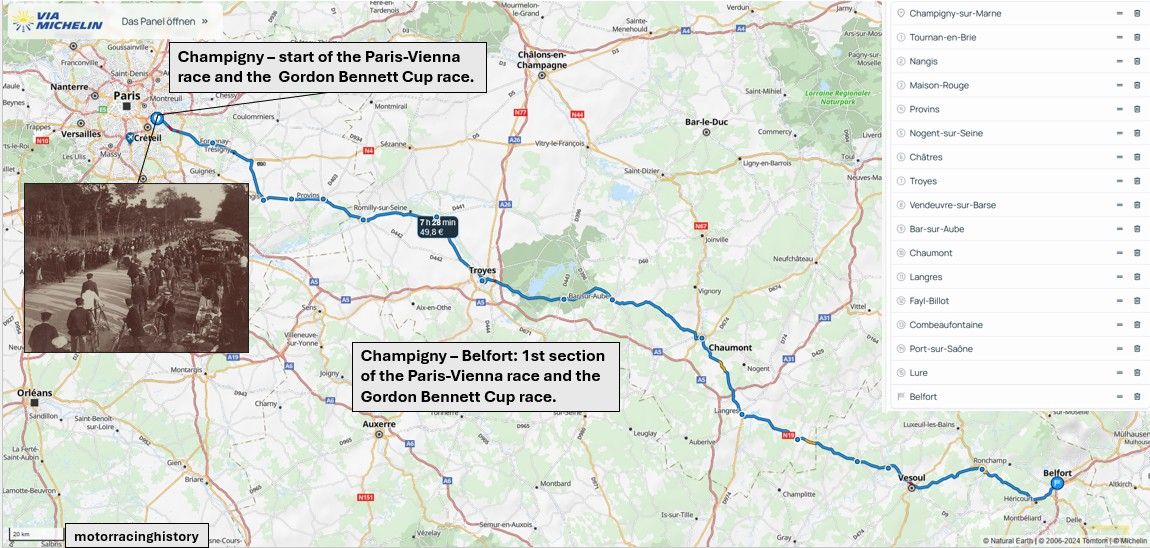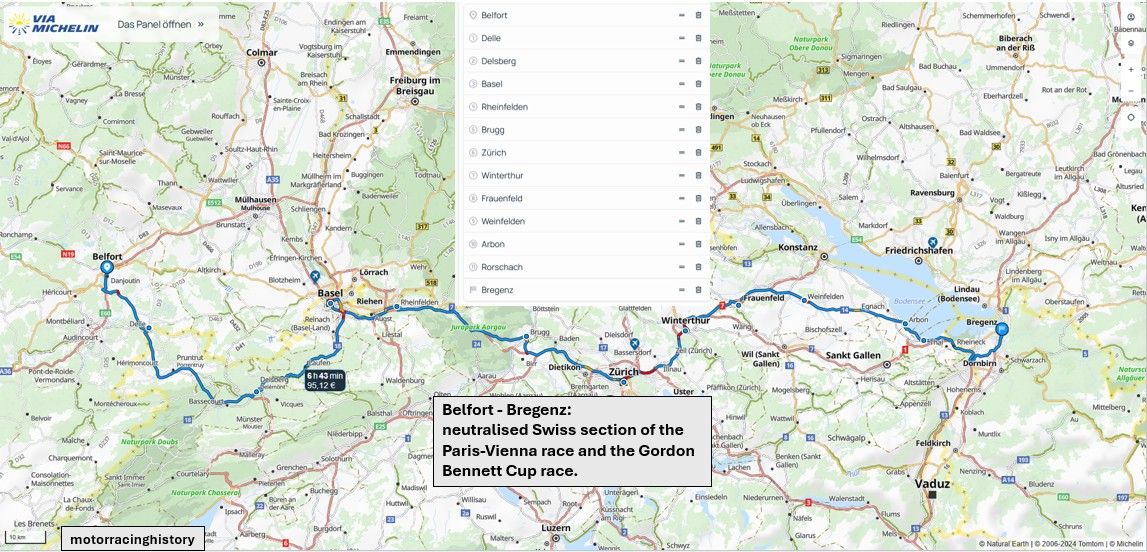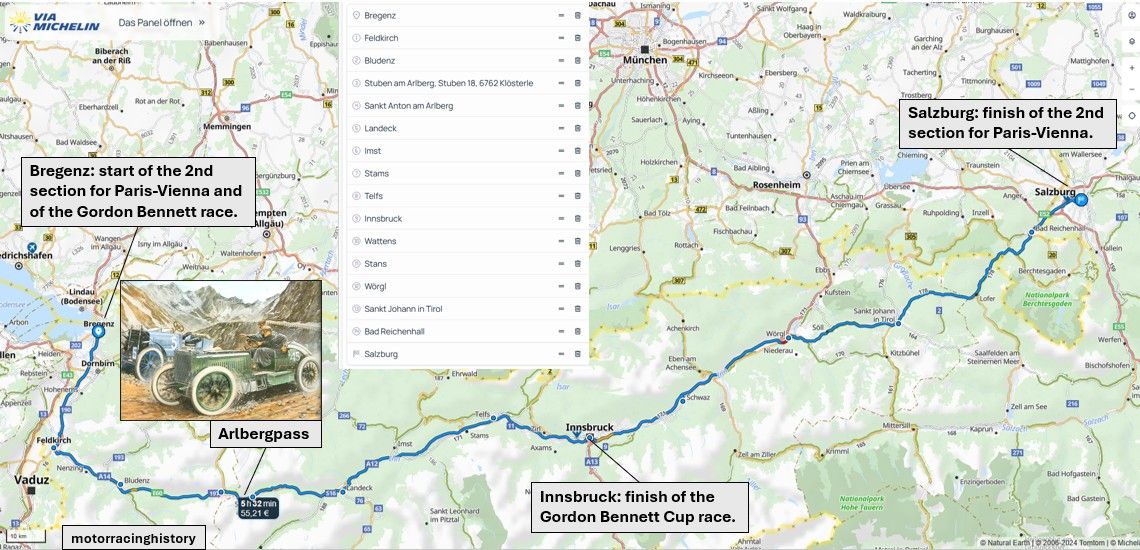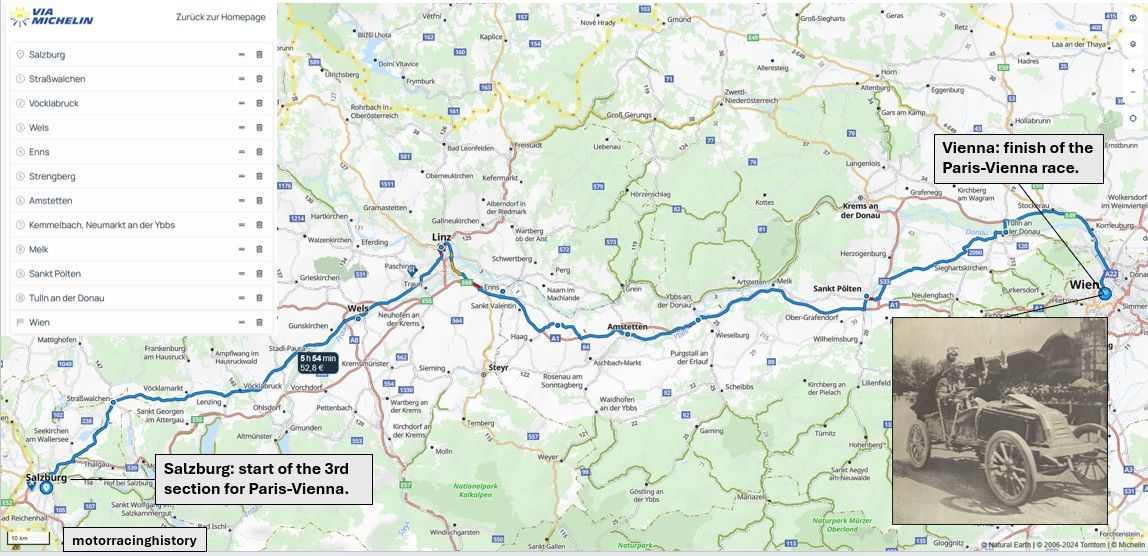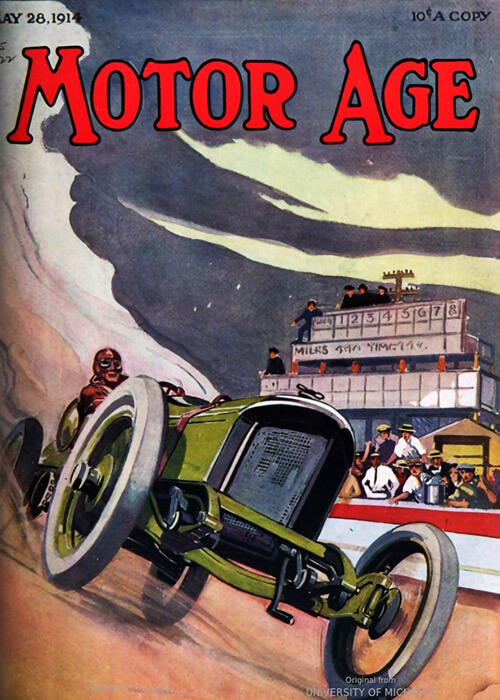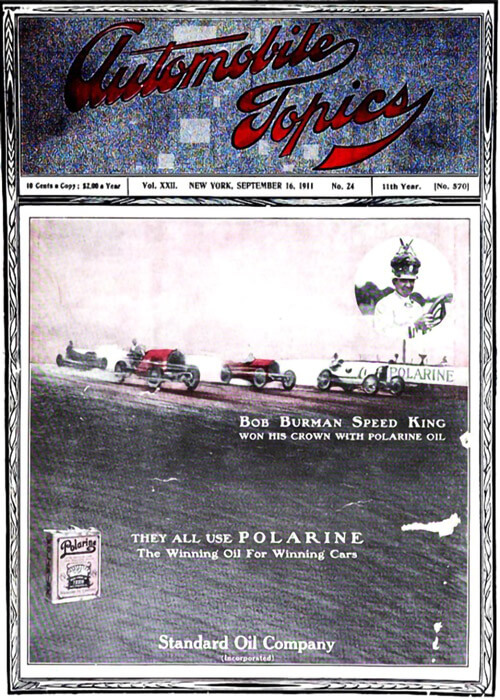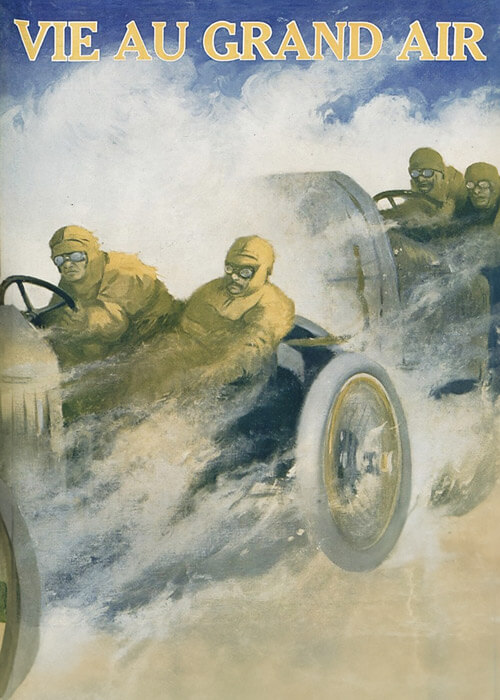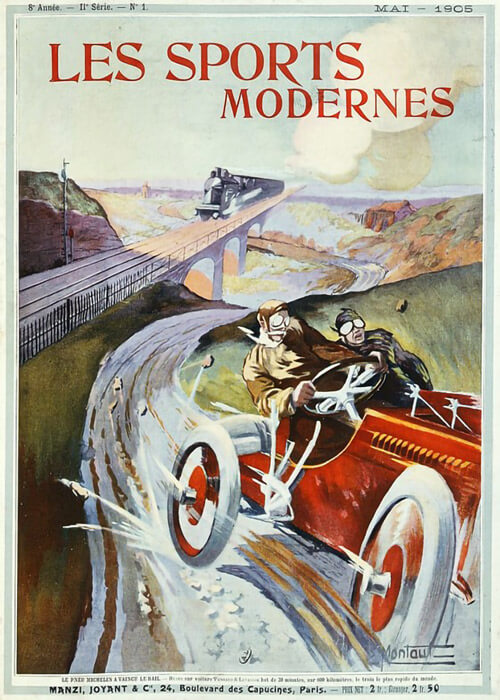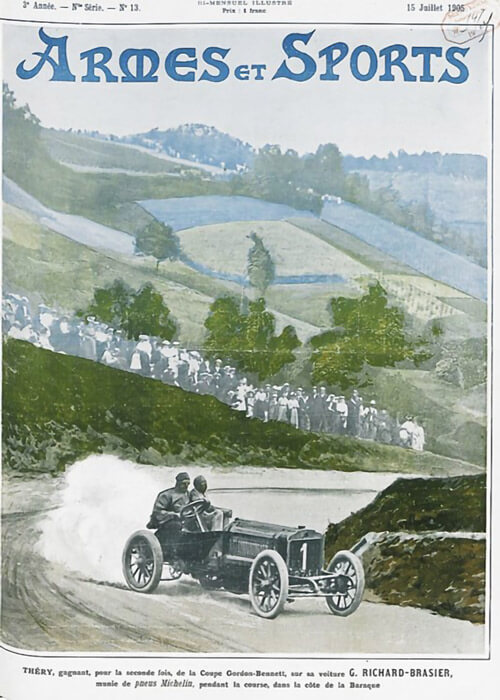First article in a series of four different reports on the 1902 Paris-Vienna Race. This one discusses the routes and the outcomes of individual days, a fine summary to begin with.
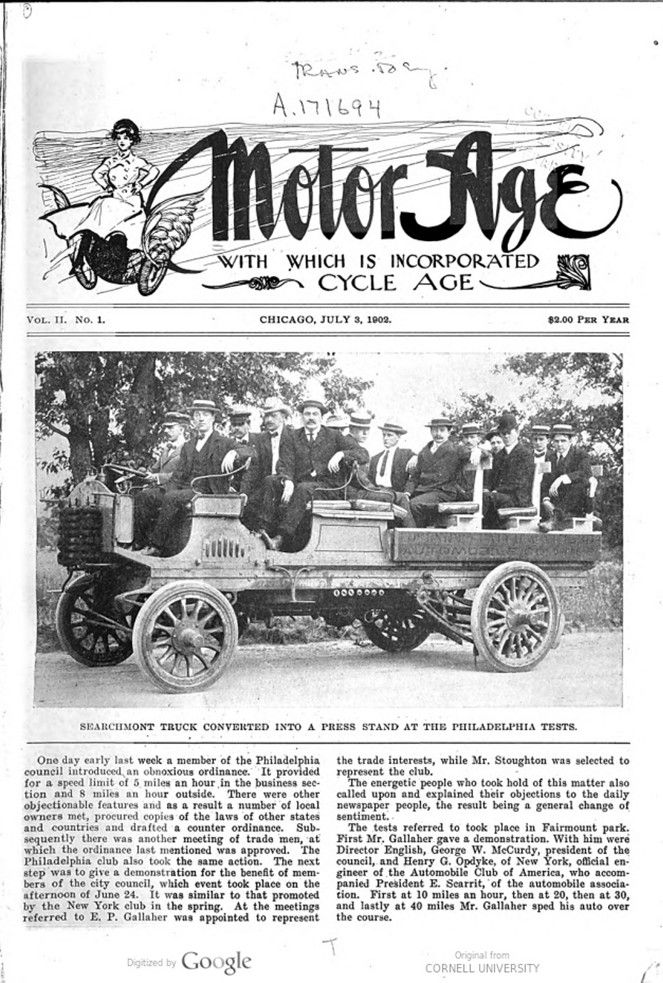
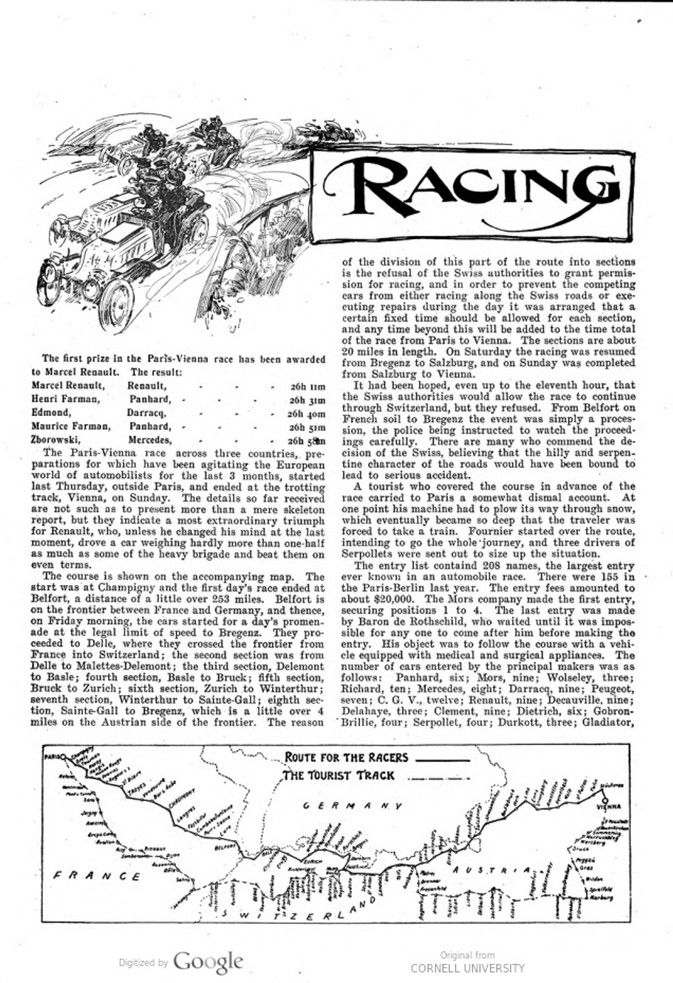
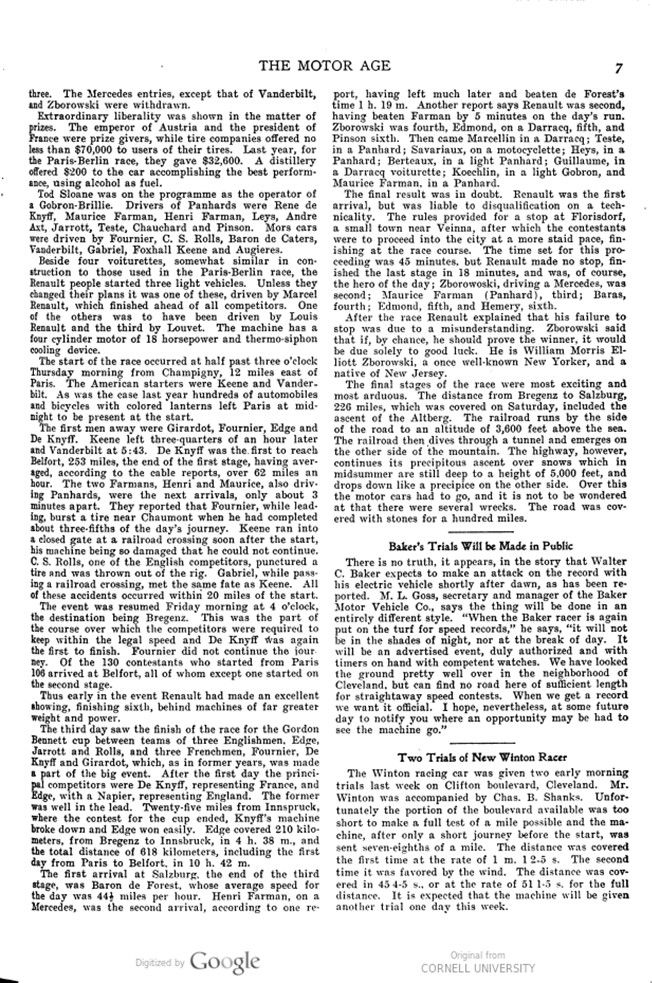
Text and jpegs by courtesy of hathitrust.org www.hathitrust.org, compiled by motorracinghistory.com
MOTOR AGE Vol. II, No. 1 – Chicago, July 1, 1902
RACING
The first prize in the Paris-Vienna race has been awarded to Marcel Renault. The result:
Marcel Renault, Renault, 26h 11m
Henri Farman, Panhard, 26h 31m
Edmond, Darracq, 26h 40m
Maurice Farman, Panhard, 26h 51m
Zborowski, Mercedes, 26h 58m
The Paris-Vienna race across three countries, preparations for which have been agitating the European world of automobilists for the last 3 months, started last Thursday, outside Paris, and ended at the trotting track, Vienna, on Sunday. The details so far received are not such as to present more than a mere skeleton report, but they indicate a most extraordinary triumph for Renault, who, unless he changed his mind at the last moment, drove a car weighing hardly more than one-half as much as some of the heavy brigade and beat them on even terms.
The course is shown on the accompanying map. The start was at Champigny and the first day’s race ended at Belfort, a distance of a little over 253 miles. Belfort is on the frontier between France and Germany, and thence, on Friday morning, the cars started for a day’s promenade at the legal limit of speed to Bregenz. They proceeded to Delle, where they crossed the frontier from France into Switzerland; the second section was from Delle to Malettes-Delemont; the third section, Delemont to Basle; fourth section, Basle to Bruck; fifth section, Bruck to Zurich; sixth section, Zurich to Winterthur; seventh section, Winterthur to Sainte-Gall; eighth section, Sainte-Gall to Bregenz, which is a little over 4 miles on the Austrian side of the frontier.
The reason of the division of this part of the route into sections is the refusal of the Swiss authorities to grant permission for racing, and in order to prevent the competing cars from either racing along the Swiss roads or executing repairs during the day it was arranged that a certain fixed time should be allowed for each section, and any time beyond this will be added to the time total of the race from Paris to Vienna. The sections are about 20 miles in length. On Saturday the racing was resumed from Bregenz to Salzburg, and on Sunday was completed from Salzburg to Vienna.
It had been hoped, even up to the eleventh hour, that the Swiss authorities would allow the race to continue through Switzerland, but they refused. From Belfort on French soil to Bregenz the event was simply a procession, the police being instructed to watch the proceedings carefully. There are many who commend the decision of the Swiss, believing that the hilly and serpentine character of the roads would have been bound to lead to serious accident.
A tourist who covered the course in advance of the race carried to Paris a somewhat dismal account. At one point his machine had to plow its way through snow, which eventually became so deep that the traveler was forced to take a train. Fournier started over the route, intending to go the whole journey, and three drivers of Serpollets were sent out to size up the situation.
The entry list contained 208 names, the largest entry ever known in an automobile race. There were 155 in the Paris-Berlin last year. The entry fees amounted to about $20,000. The Mors company made the first entry, securing positions 1 to 4. The last entry was made by Baron de Rothschild, who waited until it was impossible for anyone to come after him before making the entry. His object was to follow the course with a vehicle equipped with medical and surgical appliances. The number of cars entered by the principal makers was as follows: Panhard, six; Mors, nine; Wolseley, three; Richard, ten; Mercedes, eight; Darracq, nine; Peugeot, seven; C. G. V., twelve; Renault, nine; Decauville, nine; Delahaye, three; Clement, nine; Dietrich, six; Gobron-Brillie, four; Serpollet, four; Durkott, three; Gladiator, three. The Mercedes entries, except that of Vanderbilt, and Zborowski were withdrawn.
Extraordinary liberality was shown in the matter of prizes. The emperor of Austria and the president of France were prize givers, while tire companies offered no less than $70,000 to users of their tires. Last year, for the Paris-Berlin race, they gave $32,600. A distillery offered $200 to the car accomplishing the best performance, using alcohol as fuel.
Tod Sloane was on the programme as the operator of a Gobron-Brillie. Drivers of Panhards were Rene de Knyff, Maurice Farman, Henri Farman, Leys, Andre Axt, Jarrott, Teste, Chauchard and Pinson. Mors cars were driven by Fournier, C. S. Rolls, Baron de Caters, Vanderbilt, Gabriel, Foxhall Keene and Augieres.
Beside four voiturettes, somewhat similar in construction to those used in the Paris-Berlin race, the Renault people started three light vehicles. Unless they changed their plans it was one of these, driven by Marcel Renault, which finished ahead of all competitors. One of the others was to have been driven by Louis Renault and the third by Louvet. The machine has a four-cylinder motor of 18 horsepower and thermo-siphon cooling device.
The start of the race occurred at half past three o’clock Thursday morning from Champigny, 12 miles east of Paris. The American starters were Keene and Vanderbilt. As was the case last year hundreds of automobiles and bicycles with colored lanterns left Paris at midnight to be present at the start.
The first men away were Girardot, Fournier, Edge and De Knyff. Keene left three-quarters of an hour later and Vanderbilt at 5:43. De Knyff was the first to reach Belfort, 253 miles, the end of the first stage, having averaged, according to the cable reports, over 62 miles an hour. The two Farmans, Henri and Maurice, also driving Panhards, were the next arrivals, only about 3 minutes apart. They reported that Fournier, while leading, burst a tire near Chaumont when he had completed about three-fifths of the day’s journey. Keene ran into a closed gate at a railroad crossing soon after the start, his machine being so damaged that he could not continue. C. S. Rolls, one of the English competitors, punctured a tire and was thrown out of the rig. Gabriel, while passing a railroad crossing, met the same fate as Keene. All of these accidents occurred within 20 miles of the start.
The event was resumed Friday morning at 4 o’clock, the destination being Bregenz. This was the part of the course over which the competitors were required to keep within the legal speed and De Knyff was again the first to finish. Fournier did not continue the journey. Of the 130 contestants who started from Paris 106 arrived at Belfort, all of whom except one started on the second stage.
Thus early in the event Renault had made an excellent showing, finishing sixth, behind machines of far greater weight and power.
The third day saw the finish of the race for the Gordon Bennett cup between teams of three Englishmen, Edge, Jarrott and Rolls, and three Frenchmen, Fournier, De Knyff and Girardot, which, as in former years, was made a part of the big event. After the first day the principal competitors were De Knyff, representing France, and Edge, with a Napier, representing England. The former was well in the lead. Twenty-five miles from Innsbruck, where the contest for the cup ended, Knyff’s machine broke down and Edge won easily. Edge covered 210 kilometers, from Bregenz to Innsbruck, in 4 h. 38 m., and the total distance of 618 kilometers, including the first day from Paris to Belfort, in 10 h. 42 m.
The first arrival at Salzburg, the end of the third stage, was Baron de Forest, whose average speed for the day was 444 miles per hour. Henri Farman, on a Mercedes, was the second arrival, according to one report, having left much later and beaten de Forest’s time 1 h. 19 m. Another report says Renault was second, having beaten Farman by 5 minutes on the day’s run. Zborowski was fourth, Edmond, on a Darracq, fifth, and Pinson sixth. Then came Marcellin in a Darracq; Teste, in a Panhard; Savariaux, on a motocyclette; Heys, in a Panhard; Berteaux, in a light Panhard; Guillaume, in a Darracq voiturette; Koechlin, in a light Gobron, and Maurice Farman, in a Panhard.
The final result was in doubt. Renault was the first arrival but was liable to disqualification on a technicality. The rules provided for a stop at Florisdorf, a small town near Veinna, after which the contestants were to proceed into the city at a more staid pace, finishing at the racecourse. The time set for this proceeding was 45 minutes, but Renault made no stop, finished the last stage in 18 minutes, and was, of course, the hero of the day; Zborowoski, driving a Mercedes, was second; Maurice Farman (Panhard), third; Baras, fourth; Edmond, fifth, and Hemery, sixth.
After the race Renault explained that his failure to stop was due to a misunderstanding. Zborowski said that if, by chance, he should prove the winner, it would be due solely to good luck. He is William Morris Elliott Zborowski, a once well-known New Yorker, and a native of New Jersey.
The final stages of the race were most exciting and most arduous. The distance from Bregenz to Salzburg, 226 miles, which was covered on Saturday, included the ascent of the Altberg (GrocerJack: correct that in Arlberg). The railroad runs by the side of the road to an altitude of 3,600 feet above the sea. The railroad then dives through a tunnel and emerges on the other side of the mountain. The highway, however, continues its precipitous ascent over snows which in midsummer are still deep to a height of 5,000 feet, and drops down like a precipice on the other side. Over this the motor cars had to go, and it is not to be wondered at that there were several wrecks. The road was covered with stones for a hundred miles.
ROUTE FOR THE RACERS + THE TOURIST TRACK
PARIS – Champigny – Tournan – Nangis – Maison Rouge – Provins – Nogents – St Hilaire – TROYES – Vendeuvre – Bors. Aube – CHAUMONT – Langres – Faysbillot – Combeaufontaine – Porte Saone – Lure – BELFORT.
BELFORT – Bale – Reinfelden – Brugg – ZURICH – Winterthur – Frauenfeld – Weinfeldein – Arbon – Rorschach – BREGENZ.
BREGENZ – Dornbirn – Feldkirch – Bludenz – Stuben – St. Anton (am Arlberg) – Landeck – Imst – Telfs – Innsbruck – Hall – Stants – Kaltenberg? – Wörgl – Elmau – St. Johann – Reichenhall – SALZBURG.
SALZBURG – Strasswelchen – Wels – Linz – Enns – Strengberg – Amstetten – Kemelbach – Wels – St Pölten – Tulln – Stöckersee – VIENNA.
(GrocerJack: some names may not be correct spelled, due to the jpg-format)
